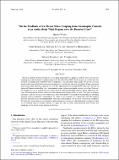| dc.contributor.author | Wang, Qiang | |
| dc.contributor.author | Marshall, John C. | |
| dc.contributor.author | Scott, Jeffery R. | |
| dc.contributor.author | Meneghello, Gianluca | |
| dc.contributor.author | Danilov, Sergei | |
| dc.contributor.author | Jung, Thomas | |
| dc.date.accessioned | 2020-04-14T21:22:23Z | |
| dc.date.available | 2020-04-14T21:22:23Z | |
| dc.date.issued | 2018-11 | |
| dc.date.submitted | 2018-09 | |
| dc.identifier.issn | 0022-3670 | |
| dc.identifier.issn | 1520-0485 | |
| dc.identifier.uri | https://hdl.handle.net/1721.1/124640 | |
| dc.description.abstract | Based on analysis of observational data it has been suggested that a negative feedback of ice-ocean stress coupling may limit freshwater accumulation in the Beaufort Gyre (BG). In this paper we explore how this feedback can significantly contribute to BG stabilization in an anticyclonic wind regime. We use an ice-ocean model and turn on and off the feedback in simulations to elucidate the role of the feedback. When a persistent anticyclonic wind anomaly is applied over the BG, liquid freshwater content (FWC) increases because of enhanced Ekman downwelling. As a consequence, ocean surface geostrophic currents speed up. However, the spinup of sea ice is weaker than the acceleration of surface geostrophic currents during wintertime, because of strong sea ice internal stress when ice concentration is high and ice is thick. This leads to cyclonic anomalies in the ice-ocean relative velocity and stress over the BG. The resultant seasonal Ekman upwelling anomaly reduces freshwater accumulation by about 1/4 as compared to a simulation with the negative feedback turned off in a control experiment, with a reduction range of 1/10-1/3 in all experiments conducted. We show that the feedback is more effective when the model's mesoscale eddy diffusivity is smaller or when sea ice internal stress is stronger. Finally, we argue that the ice-ocean stress feedback may become less significant as the Arctic warms and sea ice declines. | en_US |
| dc.description.sponsorship | National Science Foundation (U.S.) | en_US |
| dc.description.sponsorship | United States. National Aeronautics and Space Administration | en_US |
| dc.language.iso | en | |
| dc.publisher | American Meteorological Society | en_US |
| dc.relation.isversionof | http://dx.doi.org/10.1175/JPO-D-18-0185.1 | en_US |
| dc.rights | Article is made available in accordance with the publisher's policy and may be subject to US copyright law. Please refer to the publisher's site for terms of use. | en_US |
| dc.source | American Meteorological Society | en_US |
| dc.title | On the Feedback of Ice–Ocean Stress Coupling from Geostrophic Currents in an Anticyclonic Wind Regime over the Beaufort Gyre | en_US |
| dc.type | Article | en_US |
| dc.identifier.citation | Wang, Qiang, et al. “On the Feedback of Ice–Ocean Stress Coupling from Geostrophic Currents in an Anticyclonic Wind Regime over the Beaufort Gyre.” Journal of Physical Oceanography 49, 2 (February 2019): 369–83. © 2019 American Meteorological Society. | en_US |
| dc.contributor.department | Massachusetts Institute of Technology. Department of Earth, Atmospheric, and Planetary Sciences | |
| dc.relation.journal | Journal of Physical Oceanography | en_US |
| dc.eprint.version | Final published version | en_US |
| dc.type.uri | http://purl.org/eprint/type/JournalArticle | en_US |
| eprint.status | http://purl.org/eprint/status/PeerReviewed | en_US |
| dc.date.updated | 2020-04-08T18:41:39Z | |
| dspace.date.submission | 2020-04-08T18:41:47Z | |
| mit.journal.volume | 49 | en_US |
| mit.journal.issue | 2 | en_US |
| mit.license | PUBLISHER_POLICY | |
| mit.metadata.status | Complete | |
